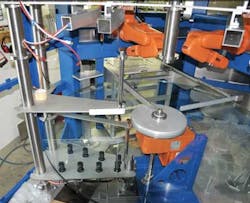VISION-GUIDED ROBOTICS: Robotic vision system checks computer keys
Before assembling individual keys, keyboard manufacturers must ensure that each one meets stringent quality control requirements.Inspecting keys for defects has traditionally been a time-consuming manual process, compounded by the fact that industrial keyboards are manufactured from more than a hundred different types of keys. These vary according to the numbers and letters printed on them and also their color.
Thanks to avision-based robotic system developed by NeuPro Solutions, this task has been completely automated (see figure). NeuPro's system sorts each key by its marking and color and ensures they meet specific quality standards before they are inserted into the empty shell of the keyboard.
To automate the inspection task, a bowl feeder filled with varieties of keys feeds keys onto a meter-wide circular rotating transparent glass plate. Once on the plate, the keys are rotated under an imaging system. There, images of the keys backlit by a white light LED illumination system are captured by four Spyder3 SG-11-2K40 2k × 1-pixel linescan cameras fromTeledyne DALSA placed across the radial length of the plate. Image data from the cameras are then transferred to a PC that computes the precise position of each key.
Because the keys can fall onto the plate in any orientation facing up or down, a second imaging station comprising a second and third set of four Teledyne DALSA Spyder3 SG-34-2K80 colorlinescan cameras placed above and below the plate used to capture an image of the alphanumeric number printed on the key and its color.
The image data are also captured by the PC where the three sets of data are correlated in an Oracle database and a map of the location, type, and color of the keys on the rotating plate is produced. Because the wheel moves at a fixed velocity, the speed and the key location map are then used to guide two robots fromABB Robotics equipped with dual gripper heads to pick up two keys at a time from the glass plate.
After turning any keys that are incorrectly oriented, each robotic head sequentially presents a pair of keys to another vision system that comprises a set of three more cameras, where they are inspected for quality.
Using a BM-500GE 5-Mpixel camera fromJAI, an image is captured and checked to ensure that the character printed on the key is to within 0.05-mm tolerance and if the quality of the printed symbol meets the demands of the manufacturer. The robot then moves the key to another BM-500GE camera where a second image of the key is checked for any surfaces scratches. Last, a third 1.2-Mpixel Genie C1280 camera from Teledyne DALSA captures an image of the key that is checked for color consistency.
Software for the system was developed using Teledyne DALSA's Sherlock software. Specific plug-ins to the software were developed by NeuPro Solutions to correct for image distortion.
By automating the key inspection process, NeuPro's system can reject any key at any stage during the inspection process, leading to increased inspection throughput. Today, the system is inspecting keys at a leading industrial keyboard manufacturer in Germany.
Vision Systems Articles Archives

